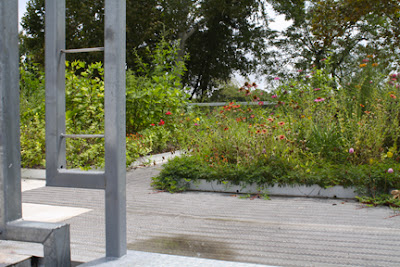 |
| Permaculture Raised Bed Cross Section |
Here is sandy Jacksonville raised beds are essential for a number of reasons.
First of all we are in hurricane territory. When Tropical Storm Fay came through several years back we had over twenty inches of rainfall within twenty four hours, almost a continual inch per hour. Water backed up and flooded our garage, rising to about an inch below the door threshold but covering the garden by several inches.
The only plants to really survive were those in the raised beds not covered by the flood waters.
But flooding is not the only reason to build raised beds, there are many more. Raised beds are typically made with compost and leaves, or organic matter. The organic material is important for several reasons.
First of all the leaves provide a source of micro nutrients such as boron (B) , iron (Fe), copper (Cu), manganese (Mn), zinc (Zn) and molybdenum (Mo). Composted leaves and kitchen scraps can add the required macro nutrients, the three main being nitrogen (N), phosphorous (P) and potassium (K).
Additional horse, cow, rabbit, chicken or other manure can be added for additional macro nutrients.
Chicken and turkey droppings should be allowed several months to cool because it is considered an 'hot' manure. Some recommend allowing hen droppings to compost for a year before using. If the chicken manure is mixed with leaves from the coop floor less composting time would be required.
Cow, horse, rabbit, duck and geese manure are considered more 'cool' manures and can be used without the long wait. In fact, vegetables have long been planted directly in horse manure collected from the streets in nineteenth century France, giving rise to the practice known as
French Intensive Gardening.Yet beyond adding micro nutrients, macro nutrients, organic matter and flood protection, raised permaculture beds offer even more benefits.
Leaf compost allows for mositure retention. Keeping the root area moist during hot dry periods is important. Leaf compost prevents vegetable bed soil from drying out as quick as those beds without compost. I've seen raised beds made of pure sand and manure turn into dried, cracked planting beds during long, hot summers. Adding leaves cools the beds, provides shade and keeps the soil moisture intact longer.
And then there is nematode protection. Nematodes devastate vegetables planted directly into our sandy soils by infecting the root area with their presence and damaging the plant's ability to transport water and nutrients up through the vascular system to the leaves. A nematode infested vegetable plant will appear stunted and produce little if any vegetables. Fortunately, nematodes do not like highly organic and composted soil. Building raised beds with organic matter, compost and leaves will help in preventing nematode infestation.
There are many more reasons for building raised permaculture beds when operating an urban core farm.
Rest assured though that your raised beds will out produce non-raised beds every season.

















